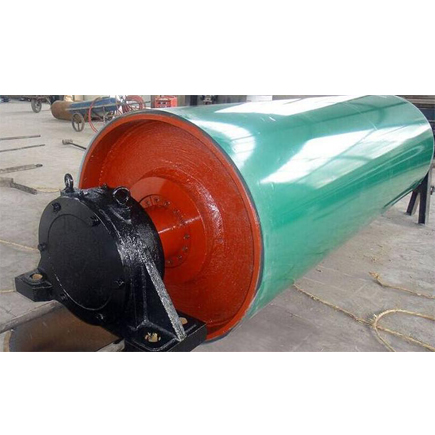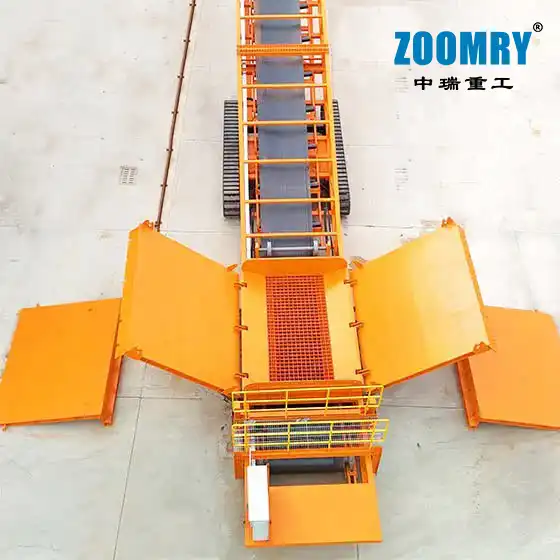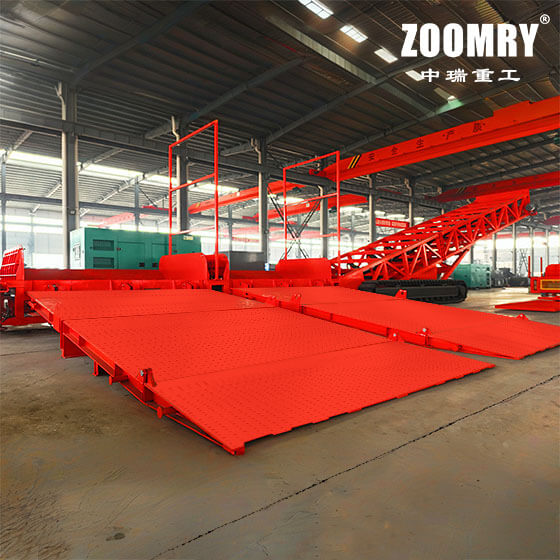ZOOMRY Tracked hopper feeder is a highly mobile feeding equipment developed specifically to address pain points in the global bulk material handling sector, such as "complex ground conditions, the need for flexible equipment relocation, and difficulties in multi-link coordination". It can seamlessly connect front-end feeding equipment (wheel loaders, grab cranes, excavators) with back-end processing equipment (belt conveyors, telescopic stackers, Mobile Ship Loaders, truck unloaders), providing domestic and foreign customers with an integrated bulk material handling solution featuring "tracked mobility + controllable feeding + multi-scenario adaptation". This completely breaks the limitations of traditional fixed feeders, such as "site restrictions and cumbersome relocation".
With a "tracked mobile chassis" as its core support, the Tracked hopper feeder combines the stability of static feeding and the flexibility of dynamic movement: the hopper capacity ranges from 7-15 m³ in the horizontal stacking state, with a maximum handling capacity of up to 1000 tons per hour (TPH). It is equipped with a 15-28 m hydraulically adjustable tilting arm, capable of stably handling various bulk materials such as aggregates, ores, and coal with a particle size of ≤150 mm. To meet multi-angle operation needs, it can be optionally equipped with a 360° central slewing bearing to further expand the operating coverage. Meanwhile, it offers two track options—steel tracks and rubber tracks—adapted to hard mine ground and soft port ground respectively. Currently, it has become the preferred equipment for high-mobility bulk material handling scenarios such as global ports, mines, and quarries.

Advantages of Tracked Hopper Feeder
The performance design of ZOOMRY Tracked Hopper Feeder is fully centered on the actual operating needs of global customers. Both the chassis mobility and feeding stability have been deeply optimized to ensure efficient and low-consumption operation in complex scenarios.
Tracked Chassis
Different from wheeled equipment that has strict requirements for ground flatness, the high-strength tracked chassis of this equipment enhances environmental adaptability through multiple designs: the track contact area reaches 2.8 m², and the ground contact pressure is as low as 0.08 MPa. It can drive stably even on sloped ground with a gradient of ≤15° or mine ground covered with gravel, without the need for additional cushioning, significantly reducing site modification investment. It is equipped with hydraulically adjustable jack outriggers, which can quickly fix the equipment after positioning, reducing chassis vibration during operation and ensuring feeding accuracy. When moving, the outriggers are retracted, and the tracks realize flexible steering through hydraulic drive, with a minimum turning radius of only 3.5 m, enabling easy relocation in narrow spaces such as gaps in port terminals and underground mine passages. In addition, steel tracks are the standard configuration, suitable for hard ground such as mines and quarries; optional rubber tracks can prevent scratches and sinking on soft ground such as port concrete floors and biomass yards, protecting the operating site environment.
Efficient Feeding and Full-Chain Collaboration
The equipment's feeding system focuses on "low loss and high stability", with key components adopting heavy-duty design: the feeding belt is a 1200 mm wide EP 500 type 3-layer structure, composed of a 5 mm base belt and a 1.5 mm wear-resistant layer, with a tensile strength of 500 N/mm, and its wear resistance is twice that of ordinary belts; the tilting arm belt is an EP 400 type 3-layer structure, with a 3 mm base belt and a 1 mm wear-resistant layer, suitable for long-distance conveying of 15-28 m, effectively reducing material scattering midway. The drive system uses a high-torque motor, supporting single-drive or dual-drive configurations. Combined with a variable frequency drive (VSD), it can realize stepless speed regulation of 0-1000 TPH, which can accurately match the handling capacity of back-end belt conveyors and mobile ship loaders, avoiding material blockage or capacity waste.
At the same time, the equipment has reserved linkage interfaces with ZOOMRY's full range of bulk material equipment during the design stage, including mechanical adaptation structures and communication interlocking devices, without the need for additional customized adapter components. When linked with belt conveyors, the discharge port of the feeder is directly connected through an adjustable chute; the chute is lined with a ceramic wear-resistant layer to reduce material impact wear, and can realize "automatic adjustment of feeding speed with conveyor load" through communication interlocking. When linked with mobile ship loaders, it can cover the entire hatch of the ship by cooperating with the ship loader's telescopic arm through the 360° rotation function, ensuring stable feeding. When linked with scraper feeders, it can receive biomass materials and convey them stably, avoiding uneven feeding caused by loose materials.
360° Omnidirectional Operation
For scenarios requiring multi-angle operations such as port ship loading/unloading and mine circular stacking, the equipment can be optionally equipped with a "central slewing bearing" component to achieve omnidirectional operation advantages: 360° rotation without dead angles, a single piece of equipment can cover an operating range with a diameter of 30-50 m (depending on the length of the tilting arm), eliminating the need for a combination of multiple fixed feeders and reducing equipment investment. In ship or barge loading/unloading operations, the equipment can move parallel to the hull through the track parallel movement function, without frequent adjustment of the overall equipment position; uniform feeding of the entire ship hull can be completed only by rotating the hopper, significantly improving loading/unloading efficiency. In mine stacking scenarios, 360° rotation combined with hydraulic lifting of the tilting arm can build conical material piles with a height of 9-13 m, and the stacking capacity is 40% higher than that of fixed feeders, making full use of site space.
Detailed Technical Parameters
ZOOMRY Tracked Hopper Feeder offers multiple model options, with core technical parameters strictly aligned with industry standards and supporting customized adjustments to ensure adaptation to different scenario needs:
| Core Parameters | Specification Range | Remarks (Based on Industry General Standards) |
|---|---|---|
| Hopper Capacity (Horizontal Stacking) | 7-15 m³ | 500-900 mm hopper opening extension section is optional; capacity can be increased by 20%-30% in the stacked state; capacity calculation is based on a material bulk density of 1.6 t/m³ |
| Maximum Handling Capacity | Up to 1000 TPH (Tons Per Hour) | Designed for aggregates, ores and other materials, with stable handling capacity; when adapting to light materials such as biomass, the output rate can be adjusted according to material characteristics |
| Adaptable Feeding Particle Size | ≤150 mm (Millimeters) | Can receive materials of this particle size conveyed by wheel loaders, excavators, and grab cranes, no additional crushing pretreatment required |
| Feeder Belt Specification | 1200 mm Wide, EP 500 Type, 3-Layer | 5 mm base belt + 1.5 mm wear-resistant layer, with a tensile strength of 500 N/mm, excellent wear resistance, extending the belt replacement cycle |
| Tilting Arm Length | 15-28 m | Folded plate or lattice structure optional, supporting hydraulic folding and lifting, facilitating transportation and adapting to different discharge heights |
| Maximum Discharge Height | 6.4-13.4 m (Adapted to Tilting Arm Length) | A 15 m tilting arm corresponds to a discharge height of approximately 6.4 m, and a 28 m tilting arm corresponds to approximately 13.4 m, matching scenarios such as ship loading/unloading and stacking/reclaiming |
| Drive Method | Single/Dual Motor Drive (Electric/Hydraulic Optional) | Electric drive is suitable for scenarios with stable external power supply; hydraulic drive is suitable for temporary operations without external power supply, with power derived from the equipment's built-in diesel hydraulic system |
| Track Type | Steel Tracks (Rubber Tracks Optional) | Steel tracks are adapted to hard ground; rubber tracks are adapted to soft ground, avoiding site damage and equipment sinking |
| Optional Functions | 360° Rotation (Central Slewing Bearing) | Reduces the frequency of overall equipment relocation, adapts to multi-angle operation scenarios, and improves operation flexibility |
| Applicable Materials | Aggregates, Ores, Sand, Coal, Cement Clinker | Not recommended for easily agglomerated materials such as wet clay and high-viscosity sludge to prevent blockage and belt adhesion |
| Protection Level (Electrical Control Part) | IP65 (NEMA-4 Class) | The electrical control box is dust-proof and waterproof, adapting to harsh environments such as high humidity in ports and high dust in quarries |
The equipment also supports multi-dimensional customized upgrades to adapt to special operation needs: for high-wear materials, the hopper inner lining can be upgraded to 10 mm hardened steel, and the drive drum can be optionally coated with ceramic rubber; for dust-sensitive scenarios, the tilting arm can be equipped with a canvas or galvanized dust cover, and a belt magnetic separator can be configured to separate metal impurities in materials; for scenarios with high safety requirements, a tilting arm anti-reversal system and a pull-cord emergency stop device can be equipped, complying with international safety standards; for biomass materials, a material agitator and herringbone pattern belt can be added to prevent material agglomeration and slipping.
In terms of power and control, the feeder and tilting arm support single-drive or dual-drive configurations, with electric drive (380V/480V) or hydraulic drive optional, adapting to different on-site energy conditions; for regions with different environmental supervision requirements, engine options complying with local standards are provided to ensure the equipment operates in compliance; the control panel is standard equipped with an HMI human-machine interface and fault display function, and radio remote control is optional, enabling full-function operation within a range of 50 m, adapting to high-risk operating environments.
Adaptable Scenarios
With "high mobility, high stability, and multi-adaptability", ZOOMRY Tracked Hopper Feeder has served customers in more than 60 countries and regions around the world, and is widely used in various high-mobility bulk material handling scenarios.
Port Ship/Barge Loading and Unloading
Traditional fixed feeders require multiple units distributed along the terminal to cover different berths. However, this tracked hopper feeder can be quickly transferred between different berths through track movement, and a single unit can meet the loading/unloading needs of 2-3 berths, significantly reducing equipment investment. Meanwhile, with the optional 360° rotation function, it can easily meet the multi-angle needs of ship loading/unloading, avoiding frequent equipment position adjustments and improving loading/unloading efficiency.
Mine Stacking and Reclaiming
Mine ground is mostly covered with gravel or has slopes, and wheeled equipment is prone to slipping and getting stuck. However, the high contact area and low ground contact pressure of steel tracks ensure the equipment can drive stably on mine ground with a slope of 12° without additional cushioning. During stacking, large-capacity material piles can be built through 360° rotation and long tilting arms; during reclaiming, it can be directly connected to the crushing station, reducing the transfer link of loaders and significantly lowering fuel consumption and equipment wear.
Quarry Aggregate Transfer
Crushed aggregates need to be transported from the crushing area to the screening/washing area. The traditional method relying on repeated transfer by loaders is prone to excessive aggregate crushing. The Tracked Hopper Feeder can be directly parked at the exit of the crusher, receive the crushed aggregates and convey them to the screening equipment through the tilting arm, realizing seamless connection of "crushing - feeding - screening", reducing aggregate loss, and at the same time lowering dust scattering, complying with environmental protection requirements.
Biomass Yard Assistance
In response to the characteristics of biomass materials—being loose and easy to agglomerate, and requiring avoidance of heat accumulation due to stacking—the equipment can be upgraded through customization to adapt: the hopper inner lining uses smooth ULF material to prevent material adhesion; a material agitator can be optionally installed to break up agglomerated materials; the tilting arm belt uses a herringbone pattern belt to prevent slipping; it can also cooperate with an aeration device to perform mild aeration on biomass during feeding, reducing heat accumulation and improving operation safety and material stability.
Why Choose ZOOMRY
Customized Adaptation Capability
ZOOMRY can flexibly adjust equipment configurations according to the customer's operating site and material characteristics: track type (steel or rubber) is selected based on ground conditions; hopper inner lining is upgraded to hardened steel or ULF wear-resistant material according to material wear degree; the tilting arm can be equipped with a dust cover or magnetic separator; feeding height and feeding speed can also be fine-tuned according to front-end equipment and back-end needs, ensuring the equipment accurately matches actual working conditions.
Full-Range Product Collaboration
ZOOMRY has a complete bulk material handling equipment matrix including belt conveyors, telescopic stackers, and mobile ship loaders. The Tracked Hopper Feeder has reserved linkage interfaces with the full range of products at the initial design stage, without the need for additional customized adapter components. When customers purchase multiple types of equipment at the same time, they can quickly realize synchronous start/stop and parameter coordination of "feeding - conveying - stacking/loading", shortening the system commissioning cycle and improving overall operation efficiency.
Rapid Service Response
Relying on a complete domestic supply chain system, the equipment has significant advantages in cost. At the same time, the transportation plan is optimized: it can be disassembled and loaded into 40-foot high-cube containers or transported by ro-ro shipping, reducing global transportation costs. In terms of technical support, through cooperation with local logistics providers in major markets such as Asia, Europe, and the Americas, "72-hour spare parts delivery" can be realized; the 24-hour remote diagnosis team can quickly locate equipment faults, and combined with the collaboration of local engineers, equipment downtime can be controlled within 48 hours, reducing production losses.
Easy Maintenance
The equipment adopts a modular design: the power unit, feeding system, and tracked chassis can be disassembled independently, and daily maintenance does not require overall disassembly, reducing maintenance man-hours; the control panel integrates multi-language interfaces including Chinese, English, Spanish, and Russian, adapting to the operating habits of operators in different regions; at the same time, a detailed maintenance manual is provided, allowing the customer team to independently complete basic maintenance such as belt tension adjustment, lubricating oil addition, and hopper cleaning, reducing dependence on external technical personnel, and the long-term use cost is significantly reduced.
Customer Service Guarantee
To ensure the efficient operation of the Tracked Hopper Feeder, ZOOMRY has built a full-process customer support system from selection to after-sales. In the selection consultation stage, customers only need to provide information such as the operating scenario, material characteristics, and handling capacity requirements. The technical team will formulate a customized selection plan through "material characteristic analysis + site space simulation", including equipment model, recommended customized components, and placement planning, avoiding efficiency waste or cost increase caused by improper selection.
In the installation and training support link, a detailed installation manual is attached when the equipment is shipped; the technical team provides 24-hour remote installation guidance and can answer installation questions in real time through video calls. When customers have needs, engineers can be dispatched to the site to assist in installation and commissioning—domestic customers can receive on-site support within 24 hours, and international customers can also get a response within 72 hours. At the same time, 1-2 days of on-site training will be provided for operators, covering equipment operation specifications, parameter adjustment methods, emergency handling procedures, etc., to ensure operators can operate the equipment independently and safely.
In terms of after-sales operation and maintenance guarantee, the equipment is equipped with an IP65-grade control panel that supports real-time data transmission. The technical team can remotely view the equipment operation parameters 24 hours a day, and 80% of common faults (such as motor overload and belt deviation) can be solved through remote guidance; common spare parts (such as belts, drive motors, and track shoes) are pre-stored by local logistics providers and can be delivered within 72 hours after the customer places an order; special spare parts can be supplemented urgently through international air transportation. After the equipment is put into operation, ZOOMRY will conduct regular return visits at 3 months, 6 months, and 12 months to understand the equipment operation status and provide professional maintenance suggestions (such as belt replacement cycle and lubricating oil model selection), helping customers extend the equipment service life and ensure long-term stable operation.

 ZOOMRY
ZOOMRY







